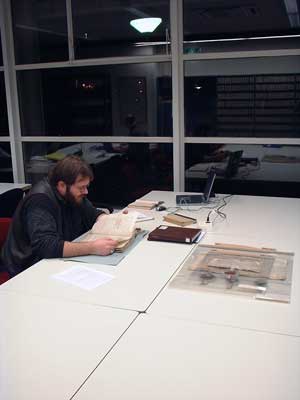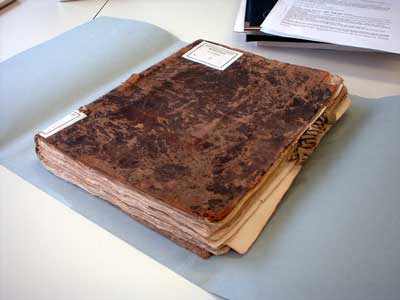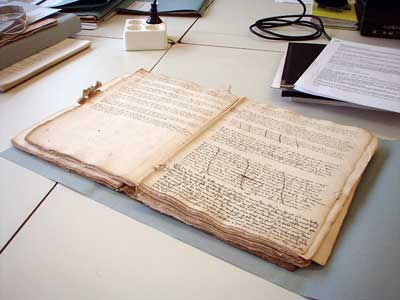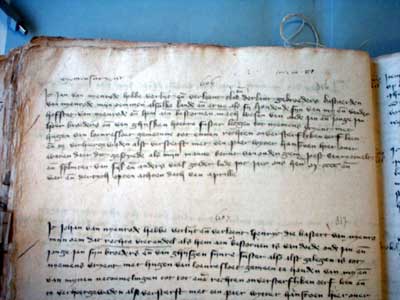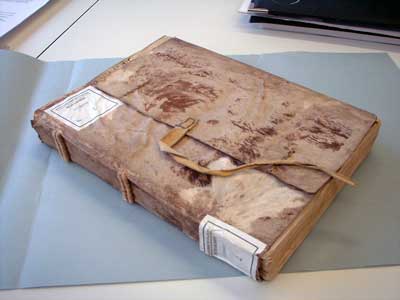The
webmasters of this site recently started researching the archives again,
this time in the Utrecht Archives. A whole day was spent on January 30th
searching very early data concerning the link between ‘Nijenrode’
and ‘Dorland’. All pertinent documents were photographed digitally
and processed with aid of a laptop computer. This way, further work out
can be done at home, which saves a lot of time in the archives itself,
since transcribing the old texts consumes a lot of time. Below a foretaste
from the approximately 120 photo’s and what we found in the registries.
Would
you like to have a go at it yourself? Check out our brainteaser!
|
| |
|
Robert
van Dorland consults a 19th century reference book. On the table two charters
(certificates) dating from 1419, with the seals of Jacon van Beyeren,
duke of Holland. The charters are well kept inside special plastic folders,
which well protects this vulnerable material. |
Eric
van Dorland holding a collection of 15th century duplicates of the Utrecht
City Council outgoing letters. The Utrecht Archives has adapted itself
to modern times, e.g. by putting in power sockets, so laptop computers
and digital camera’s can be used in aid of the research nowadays.
|
|
|
One
of the celebrated ‘registers of feoffs and rents’ of the castle
‘Nijenrode’ at Breukelen, Holland. This boek contains entries
between 1430-1455. There are 7 of these registers, of which each one has
to be glanced through in order to dig up records of the first known Dorlands. |
Same
register as show on the left, but now opened. The paper itself is in remarkable
good condition, considering that it is about 600 years old. Not only the
language of those days, but also the writing itself is quite different
from what we are used to nowadays. It takes practice to be able to read
it properly.
|
|
|
Here is the first
mention of the name ‘Dorland’ which we were able to find
–so far- as an original. It dates from April 8th 1434 and is about
a feoff granted by ‘Jan van Nijenrode’ to ‘Claes’
and ‘Dorlant’, who, apart from being half brothers, were
also bastards of the lord of Nijenrode. Below the transcription of the
text involved:
|
Beautifull example of fifteenth century bookbinding. Cleary visable
is the use of an animalskin (complete with hair) as a binding. It is
actually the second part of the ‘registers of feoffs and rents’
of the castle ‘Nijenrode’ at Breukelen, from the period
1454-1468.
|
nyemensvryent
=Niemandsvriend
(translates as ‘no-mans
friend’)
606
Ic
Jan van nyenrode hebbe verlyt en(de) verleent Claes en(de) Dorlant
gebroeders bastaerden
I, Jan van Nijenrode have granted the feoff
to Claes and Dorlant, brothers, bastards
van nyenrode myn oemmen alsulke lande en(de) erve als sy houdende
syn van my en(de) vander
of Nijenrode, my uncles, all lands and properties
as they keep from me and from the
hofstat van nyenrode en(de) hem aen bestorven mach wesen van oude
Jan en(de) jonge Jan
homestead of Nijenrode and are heritable from
old Jan and young Jan
haer broeders en(de) van Ghysken haerre suster leggen tot nyemens
vryent met
their brothers and from Ghysken their sister
located at Niemandsvriend with
Hugen van Loenresloet gemeenne tot ennen rechten onversterflyken eerfleen
Hugen van Loenresloot will be an inheritable
loan
en(de) te verheergewaden alst versterft met een paar wyter hanscoen*
hier over
to be compensated when it ceases with a pair
of white gloves*. those
waren daer dit geseyede als myn manne Bernt van Oudengem Joest van
Nyervelt
who witnessed this were my men Bernt van Oudegem,
Joest van Nijervelt
en(de) Splinter van Syl en(de) andere(en) veel goeden lude int jaer
ons her(en) (dusent) cccc en(de)
and Splinter van Sijl and many other good people
in the year of our Lord thousand four-hundred and
vier en(de) dertych opten achten dach van aprille.
thirty-four on the eight day of April.
transcriptie:
vandorland.nl 01-02-2003
Translation: vandorland.nl 01-02-2003
*
'wyter hanscoen'= witte handschoen, werd overdrachtelijk gebruikt
om een overeenkomst te bezegelen.
* ‘white gloves’ used symbolically
to confirm an agreement.
(uit
Middelnederlansch Handwoordenboek, Martinus Nijhoff, 's Gravenhage:
"Handschoen; ook als zinnebeeld bij de overdracht van sommige
onroerende goederen" )
|
![]()

